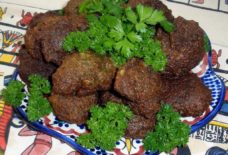Leila Khoury and the Sculpture of Nizar Qabbani
Dan Hanson’s BlogBy: Ala Abed-Rabbo/Arab America Contributing Writer
Leila Khoury and the Syrian Community
Cleveland, Ohio is a city that is home to 120 or so various ethnic groups. Each sub-group brings their unique traditions, attire, music, religion, art, cuisine, and more.
Leila Khoury, a young Syrian rising star in that city and nationally, received her BFA in Interdisciplinary Sculpture from Maryland Institute College of Art. She created a sculpture of the famous and late Syrian international Poet, Nizar Qabbani; it is publicly and proudly installed in Cleveland’s Syrian Cultural Garden.
The project took place during the year of 2014 – 2015, while Khoury was completing her undergrad in Baltimore. When she came home to Cleveland for her summer vacation, she molded the sculpture from clay in a small Cleveland Heights studio. Currently, Leila is a candidate for a Master’s degree in Architecture and also a candidate for a certificate in historic preservation from the School of the Art Institute of Chicago.
She was working directly with a local foundry called, Studio Foundry, which did the bronze-cast of the piece after she finished molding it. Leila Khoury’s aim with the sculpture was to commemorate an artistic and literary figure in Syria’s recent history who had an enormous impact on Syrians, considering the current divisiveness of the nation.
Leila Khoury, at a young age in Cleveland, agonized over the results of death and destruction in the homeland of her family, a conflict that caused the displacement of millions of Syrians around the world, and the arbitrary demolition of some cultural heritage locations.
Khoury has seen how the calamity of the war has obstructed the sizable Syrian community in America. Regardless of the religious belief or political viewpoint, the Syrian American population has recently been alarmed by the unsafe surroundings of their hometowns abroad. Such a happening motivated Leila to restore her community’s confidence in their history and their glorious artistic abilities.
Nizar Qabbani and his Memorial
KickstarterMoreover, it’s important to add that the figure that young Khoury idealized, the late Nizar Tawfiq Qabbani, was not only an international poet but also a lawyer, diplomat, writer, and editor. His lyrical approach blends minimalism and grace in exploring themes of love, women’s liberation, religion, and Arab nationalism. Qabbani is one of the most respected modern poets in the Arab world and is believed to be Syria’s National Poet.
For many years, Cleveland’s immigrant groups have admired their national heroes in a sequence of cultural gardens on the city’s east-side. The Cleveland artist, Leila Khoury, created her praise to poet Nizar Qabbani from foundry to setting up in the Syrian Cultural Garden.
Leila Khoury’s Inspiration
IdeastreamAs an artist, Khoury believes that her imaginative expression is her most effective instrument in countering the Syrian war itself and how it has traumatized the community that she grew up in.
Therefore, she chose to sculpt a bronze bust of the late Syrian poet Nizar Qabbani. To Syrians, he is a uniting figure and a symbol of peace. His writing and heritage of social involvement are widely respected. Qabbani’s poetry describes the representation of his deep love for Syria and his activism for the social equality of its people.
Moreover, the Syrian Cultural Garden symbolizes the Syrian community at large and thus is the idyllic space to honor him. The Syrian Cultural Garden was built in 2011, and it includes aspects that embody the objects of Syria’s history.
The Installation of Nizar Qabbani’s Sculpture
Creating Qabbani from David C Barnett on Vimeo.
The Garden’s association’s board has approved Khoury’s proposal to sculpt a figurative portrait of Qabbani and was installed by May 2015. In the city of Cleveland, the Garden is among 25 other cultural gardens, each signifies a diverse ethnic community that has contributed to the legacy of Cleveland.
Therefore, each Garden’s visual is distinctive in its structural design, landscaping, and demonstration of art. Many of them include bronze sculptures to honor the prominent thinkers of their histories.
What does Nizar Qabbani Mean to Leila Khoury
Cleveland PeopleAccording to Khoury, Qabbani believed that a person may be critical but at the same time be peaceful. Also, he regularly directed his support for social equality in Syria through a voice of nonviolent struggle. Reasons for the fairness of women and dissatisfaction with authoritarian rule surfaced as symbols of Qabbani’s poetry. Such beliefs gave him certain public admiration.
However, it was his artistic methods of preventing confrontational style that gained the favor of political leaders. Qabbani’s short poems spoke volumes. Also, they encourage the kind of peaceful thought and action that is alone competent in stopping Syria’s withstanding civil war.
Khoury showed this tremendous artistic expression of ideas tied to her legacy and childhood. She let her Syrian origin to discover new depth in her creative abilities.
Just like Nizar Qabbani, Khoury wishes to return to her hometown in Syria. She anticipates that the art in her studio is not the final word in her family’s native country.
If the war in Syria goes on, it is hard to argue that Nizar Qabbani could prophesize what is coming, “but with any luck, his poetic verse might: “Arab children, Spring rain, Corn ears of the future, You are the generation that will overcome defeat.”
The Challenge Khoury Faced
KickstarterKhoury recalled the incredible enjoyment of working on the Qabbani sculpting project. However, she encountered the complexity of funding the installation of the art piece and the bronze casting process. In Cleveland, Khoury embarked on professionally requesting funding from individuals and also from artistic and cultural foundations to cover the costs.
Leila Khoury stated, “Looking forward, I aim to depart from notions of personal memory and turn my focus to the historic systems of power which presently separate Arab societies from their cultural heritage.”


